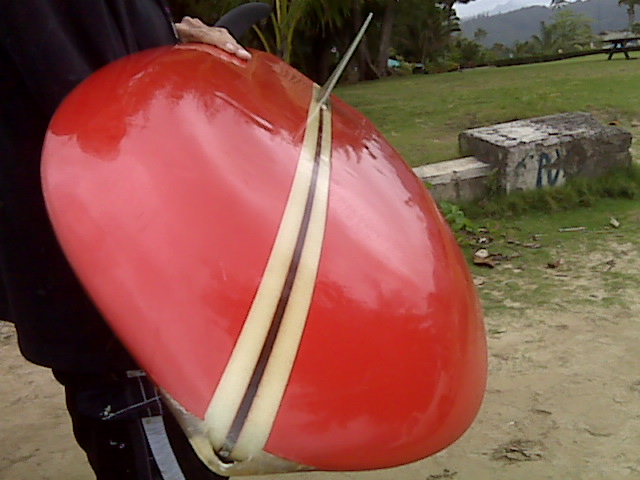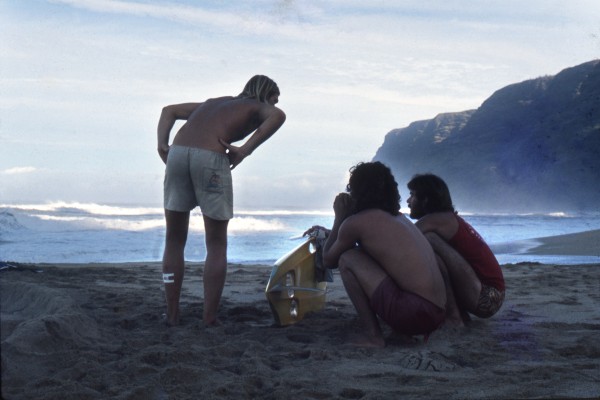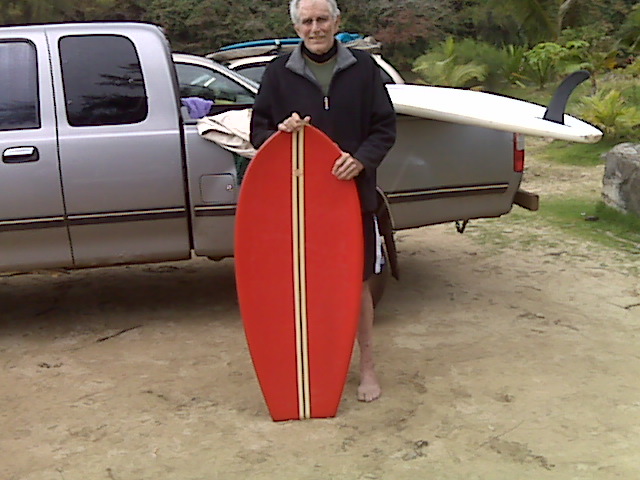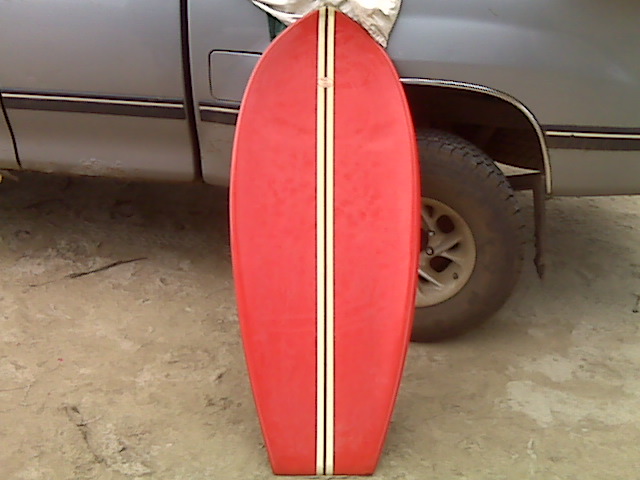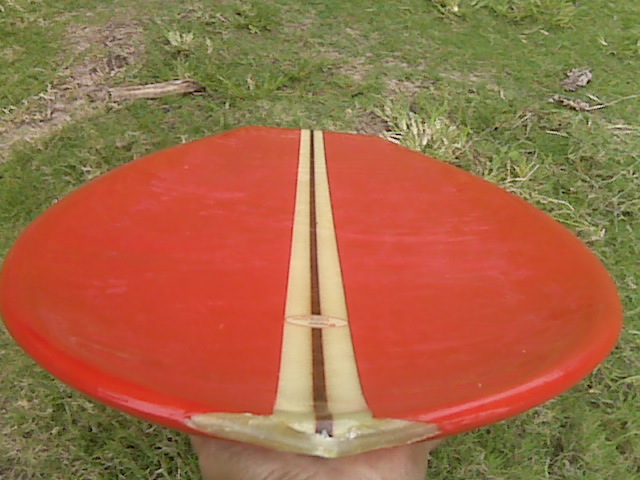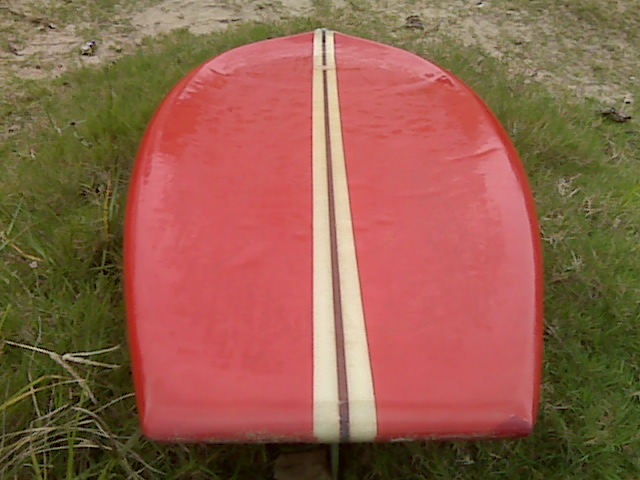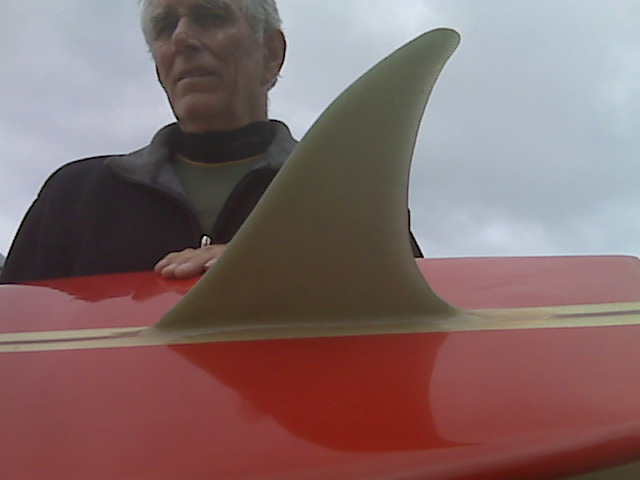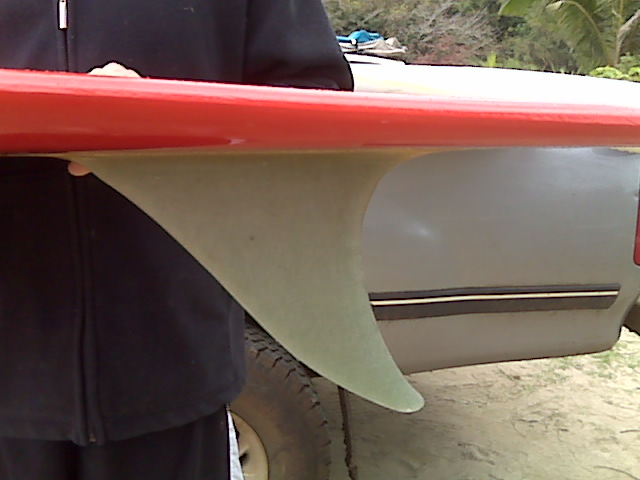| Vinny Bryan Paipo Interview January 26, 2010. Kauai, Hawaii Questions and telephone interview by Bob Green Interview organized by Mike "Wild Dog" Williams Photos courtesy of Peter Pope Kahapea (Click on images for a larger view) |
|||||||||||||||||||||
| Introduction. The story of a paipo board returned to its builder and gifter, Vinny Bryan, after 45 years (as related by Peter Pope Kahapea). Went
to go hang at the beach yesterday, a typical afternoon yet.. an old
friend had just gotten out of the water, old like me in years, one who
loved his beer and has a few dents in his truck to prove it yet... in
the back of his truck.... he had this .... returned to him some 44 / 45 years later by the same young boy that he gave it to in San Luis Obispo. Vinny was a young man going to college and had a surf shop in the San
Luis Obispo area then, in the mid-1960s, trying to make a go of his life with
a child on the way. Central Coast Surf Shop was the name, and Vinny
Bryan was his name. Vinny gave this paipo board to a young boy and
recently the father of this boy (Justin Bullock, now a grown man) was told to return
this paipo board back to Vinny here on Kaua`i. I cannot express the thrill it was to pick up and handle this "sweet relic" from some 40 years ago. It's in such wonderful conditions. Made of foam with some indentations, but minor. no breaks in the fiberglass at all. What a wonderful piece of surfing history for sure!!! I got chicken skin touching this paipo board. The thoughts and time that went into the making of this paipo board. Mahalo Vinny Bryan for a beautiful part of paipo board history. |
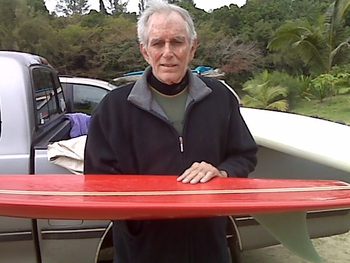 Vinny and the board returned to him after 45 years |
||||||||||||||||||||
|
1. We’ve been doing interviews with guys who have had involvement with paipo boards/bellyboards. You mightn’t be talking to the right guy. I’ve made a couple of them, but not a whole lot of them.2. When did you first start making or riding bellyboards/paipo? Where was this? On Oahu in the 1950s.3. I’ve seen the photo of the red board on the Surfer mag forum that Peter Pope Kahapea posted. Is this typical of the bellyboards that you made? [See Note 1] Oh yeah, I know, they were ones from the 1960s. They were kind of like the George Greenough design. Spoons.4. How did they differ from the ones in the 1950s? They have the spoon, the front end was turned way up. They were dished out - a lot of dish in them. George Greenough was riding stuff like that in the 1960s. I was making boards in Californa when I came across the design. I made two or three of them.
San Luis Obispo -- the Morro Bay area.6. What sort of waves were these boards made for? Was it a kneeboard or to be ridden prone? Hollow waves. Good waves. You could ride them either way.7. How many do you reckon that you made? Over the years a dozen. But that’s over the years. When I was a kid we made all sorts of stuff.8. Were they the ply paipos? We made plywood ones. In the late 1950s we probably made a couple of foam ones. I can remember a couple. We always made our own boards, most of the time anyway.9. Do you see much difference in the design principles for bellyboards and stand-up boards? They’re just stretched out. That’s all there is to it. Stretching it out.10. I heard you won a contest on a 4’6” board in 1970, at Honalua Bay. No, it was 5’10".11. How short did you get down to? As short as 5’5”. But that was someone else’s board. That was getting too small. We tried t keep it as close to eyeball height. We were riding really small boards then.12. What influenced you then – there were guys riding stand-up paipo back then? Oh, I don’t know. This was the late 1960s. We just started making smaller boards so we could ride places no one else would ride. That’s pretty much how it happened. Then they got crowded. There were no cords, no nothing, so we were able to ride waves nobody else wanted to ride. Hollower waves that the bigger, longer boards didn’t work in. A couple of guys were riding knee boards that could go fast enough.13. Did you experiment much with bellyboard design? Not too much. Not really much.14. I gather you experimented with stand-up boards. What was the most radical board that you made? Oh yeah. There were lots of kinds of strange ones that people would think were weird. Some were weirder than others. Some ideas worked better than others, too. But I don’t know what would be the most ridiculous. There was some pretty ridiculous stuff. Hours and hours of work for five minutes of finding out that you were totally wrong. That’s not an unusual occurrence. I have done some boards that were designed to reduce wetted surface area drag. They are very fast but hard to make.15. Did you ride bellyboards much when you got older? No, not too much. Just stand-up.16. When attracted you to bellyboards when you were younger? The Makaha shorebreak. It was a lot of fun. You could have a lot of fun with it. They’re really easy to play with. In those days you could make them out of anything. We made a lot of ply ones. It’s a good water toy for kids. God they’re wonderful, that’s why the boogie board is so popular.17. Some guys rode them in serious waves, like Sean Ross at Pipeline and John Galera at Jockos. Oh yeah. I'vr seen that. I love it.18. I’ve read on the SurferMag Forum about the board that was returned to you, 44 or 45 years later? Yeah, that’s right.19. What’s the story behind that? I made it for a friend of mine in college when I had a surfboard shop and was going to school. He had it, then he gave it to his son. His son moved to Maui and he found out I was still here. Then he moved to Australia – somewhere in Queensland right now. He’s quite a water guy.20. What was his name? Justin Bullock. He’s quite a character. He’s done some movie work. Give him my love if you see him. His father and I were close friends in college and we surfed together. I made him that board. Justin had the board on Maui and brought it over and gave it to me. He was giving all his boards away. He couldn’t afford to send them to Australia. He had a bunch of happy Hawaiians in his backyard for a while. He had a pile of really nice boards. He got in touch with me and gave it back. It looked almost as good as the day as it was made. It was beautiful.21. What was it like getting that board back after all those years? It blew my mind. Amazing. I did some pretty good work back then. It is all 10 oz. cloth man and you don’t see that much anymore. The resin was hard as a rock. They took good care of it. I was absolutely amazed.22. Have you used it? No. I have a grandson who might use it.23. Was it made to be ridden on you knees or prone? Either way. If you were to ride it on your knees you had to get into a really teeny ball. It’s really short and it was kinda cool. I rode it 4 or 5 times. But it was in California and the water was cold. Who likes that?24. What was cool about it? What did you enjoy about the board? It was fun, it’s just a fun board. It was fast, pretty fast. A square tail. I’d make it a little different now. That was a long time ago.25. How would you make it different now? I’d make the rails sharper, still like that. If the rails were sharper you’d get more release, that would be nice, a bit more punch out of it. The rails were a little too rounded for me. I like them squarer thank you. Not square, but I want the water to go away.26. Do you have any other comments? If you surf don’t stop. That was a Miki Dora or somebody like that. Go surfing every chance that you can. Enjoy it. When you can’t you’ll be bummed. Appreciate it. Please, and be nice, that’s always good.
|
|||||||||||||||||||||
|
Note 1. See the interview here on the SurferMag Message Boards, http://forum.surfermag.com/. A PDF version is here. |
|||||||||||||||||||||
|
Feel free to send me suggestions, comments and additional information to: The Paipo Interviews.
|
|||||||||||||||||||||

